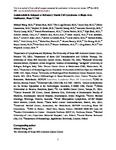Acalabrutinib in relapsed or refractory mantle cell lymphoma (ACE-LY-004): a single-arm, multicentre, phase 2 trial
| dc.contributor.author | Wang, M | |
| dc.contributor.author | Rule, S | |
| dc.contributor.author | Zinzani, PL | |
| dc.contributor.author | Goy, A | |
| dc.contributor.author | Casasnovas, O | |
| dc.contributor.author | Smith, SD | |
| dc.contributor.author | Damaj, G | |
| dc.contributor.author | Doorduijn, J | |
| dc.contributor.author | Lamy, T | |
| dc.contributor.author | Morschhauser, F | |
| dc.contributor.author | Panizo, C | |
| dc.contributor.author | Shah, B | |
| dc.contributor.author | Davies, A | |
| dc.contributor.author | Eek, R | |
| dc.contributor.author | Dupuis, J | |
| dc.contributor.author | Jacobsen, E | |
| dc.contributor.author | Kater, AP | |
| dc.contributor.author | Le Gouill, S | |
| dc.contributor.author | Oberic, L | |
| dc.contributor.author | Robak, T | |
| dc.contributor.author | Covey, T | |
| dc.contributor.author | Dua, R | |
| dc.contributor.author | Hamdy, A | |
| dc.contributor.author | Huang, X | |
| dc.contributor.author | Izumi, R | |
| dc.contributor.author | Patel, P | |
| dc.contributor.author | Rothbaum, W | |
| dc.contributor.author | Slatter, JG | |
| dc.contributor.author | Jurczak, W | |
| dc.date.accessioned | 2018-02-16T10:46:25Z | |
| dc.date.available | 2018-02-16T10:46:25Z | |
| dc.date.issued | 2018-02-17 | |
| dc.identifier.issn | 0140-6736 | |
| dc.identifier.issn | 1474-547X | |
| dc.identifier.uri | http://hdl.handle.net/10026.1/10796 | |
| dc.description.abstract |
BACKGROUND: Bruton tyrosine kinase is a clinically validated target in mantle cell lymphoma. Acalabrutinib (ACP-196) is a highly selective, potent Bruton tyrosine kinase inhibitor developed to minimise off-target activity. METHODS: In this open-label, phase 2 study, oral acalabrutinib (100 mg twice per day) was given to patients with relapsed or refractory mantle cell lymphoma, until disease progression or unacceptable toxicity. The primary endpoint was overall response assessed according to the Lugano classification, and safety analyses were done in all participants. This trial is registered with ClinicalTrials.gov, number NCT02213926. FINDINGS: From March 12, 2015, to Jan 5, 2016, 124 patients with relapsed or refractory mantle cell lymphoma were enrolled and all patients received treatment; median age 68 years. Patients received a median of two (IQR 1-2) previous therapies. At a median follow-up of 15·2 months, 100 (81%) patients achieved an overall response and 49 (40%) patients achieved a complete response. The Kaplan-Meier estimated medians for duration of response, progression-free survival, and overall survival were not reached; the 12-month rates were 72% (95% CI 62-80), 67% (58-75), and 87% (79-92%), respectively. The most common adverse events were primarily grade 1 or 2 and were headache (47 [38%]), diarrhoea (38 [31%]), fatigue (34 [27%]), and myalgia (26 [21%]). The most common grade 3 or worse adverse events were neutropenia (13 [10%]), anaemia (11 [9%]), and pneumonia (six [5%]). There were no cases of atrial fibrillation and one case of grade 3 or worse haemorrhage. The median duration of treatment was 13·8 months. Treatment was discontinued in 54 (44%) patients, primarily due to progressive disease (39 [31%]) and adverse events (seven [6%]). INTERPRETATION: Acalabrutinib treatment provided a high rate of durable responses and a favourable safety profile in patients with relapsed or refractory mantle cell lymphoma. These findings suggest an important role for acalabrutinib in the treatment of this disease population. FUNDING: Acerta Pharma, a member of the AstraZeneca Group. | |
| dc.format.extent | 659-667 | |
| dc.format.medium | Print-Electronic | |
| dc.language | en | |
| dc.language.iso | en | |
| dc.publisher | Elsevier | |
| dc.subject | Aged | |
| dc.subject | Benzamides | |
| dc.subject | Dose-Response Relationship, Drug | |
| dc.subject | Female | |
| dc.subject | Humans | |
| dc.subject | Lymphoma, Mantle-Cell | |
| dc.subject | Male | |
| dc.subject | Middle Aged | |
| dc.subject | Protein Kinase Inhibitors | |
| dc.subject | Pyrazines | |
| dc.subject | Recurrence | |
| dc.subject | Survival Analysis | |
| dc.subject | Treatment Outcome | |
| dc.title | Acalabrutinib in relapsed or refractory mantle cell lymphoma (ACE-LY-004): a single-arm, multicentre, phase 2 trial | |
| dc.type | journal-article | |
| dc.type | Article | |
| plymouth.author-url | http://gateway.webofknowledge.com/gateway/Gateway.cgi?GWVersion=2&SrcApp=PARTNER_APP&SrcAuth=LinksAMR&KeyUT=WOS:000425287800025&DestLinkType=FullRecord&DestApp=ALL_WOS&UsrCustomerID=11bb513d99f797142bcfeffcc58ea008 | |
| plymouth.issue | 10121 | |
| plymouth.volume | 391 | |
| plymouth.publication-status | Published | |
| plymouth.journal | The Lancet | |
| dc.identifier.doi | 10.1016/S0140-6736(17)33108-2 | |
| plymouth.organisational-group | /Plymouth | |
| plymouth.organisational-group | /Plymouth/Faculty of Health | |
| plymouth.organisational-group | /Plymouth/Faculty of Health/Peninsula Medical School | |
| plymouth.organisational-group | /Plymouth/REF 2021 Researchers by UoA | |
| plymouth.organisational-group | /Plymouth/REF 2021 Researchers by UoA/UoA01 Clinical Medicine | |
| plymouth.organisational-group | /Plymouth/REF 2021 Researchers by UoA/UoA01 Clinical Medicine/UoA01 Clinical Medicine | |
| plymouth.organisational-group | /Plymouth/Research Groups | |
| plymouth.organisational-group | /Plymouth/Research Groups/Institute of Translational and Stratified Medicine (ITSMED) | |
| plymouth.organisational-group | /Plymouth/Research Groups/Institute of Translational and Stratified Medicine (ITSMED)/CBR | |
| plymouth.organisational-group | /Plymouth/Research Groups/Institute of Translational and Stratified Medicine (ITSMED)/CCT&PS | |
| plymouth.organisational-group | /Plymouth/Users by role | |
| plymouth.organisational-group | /Plymouth/Users by role/Academics | |
| dc.publisher.place | England | |
| dcterms.dateAccepted | 2017-11-24 | |
| dc.identifier.eissn | 1474-547X | |
| dc.rights.embargoperiod | Not known | |
| rioxxterms.versionofrecord | 10.1016/S0140-6736(17)33108-2 | |
| rioxxterms.licenseref.uri | http://www.rioxx.net/licenses/all-rights-reserved | |
| rioxxterms.licenseref.startdate | 2018-02-17 | |
| rioxxterms.type | Journal Article/Review |


